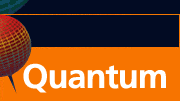CONTACTS
 |


Quantum Initiative: Quantum Lunch
The Quantum Lunch is regularly held on Thursdays in the Theoretical Division Conference Room, TA-3, Building 123, Room 121.
The organizing committee includes Malcolm Boshier (P-21), Lukasz Cincio (T-4), Diego Dalvit (T-4), Changhyun Ryu (P-21) , Nikolai Sinitsyn (T-4), Rolando Somma (T-4), Yigit Subasi (T-4), Christopher Ticknor (T-1), and Wojciech Zurek (T-4).
For more information, or to nominate a speaker, contact Yigit Subasi or Lukasz Cincio.
To add your name to the Quantum Lunch email list, contact Kacy Hopwood.
Thursday July 27, 2017
12:30 PM - 2:00 PM
Speaker: Xiao-Feng Qian (University of Rochester)
Technical Host: Lukasz Cincio
TOPIC: Light Complementarity: Beyond Wave and Particles
Abstract
The understanding of the nature of light has been one of the most fundamental and ancient issues of science history. Wave and particle are two dominating interpretations of light. The debate of light being either a particle or a wave has gone back and forth over the centuries from Newton's corpuscular theory and Huygens' wave description in the 17th century, through the prevalence of wave interpretation in the 19th century due to Fresnel, Young, and Maxwell, all the way to Einstein's photoelectric effect of photon description and de Broglie's matter wave theory in early 20th century. The widely accepted qualitative resolution has been Bohr's complementarity principle which states that light is actually BOTH wave and particle but they are two mutually exclusive properties. Initiative search of a comprehensive quantitative analysis of this wave-particle duality picture wasn't carefully pursued until around the 1980s by Wootters-Zurek, Glauber, and Mandel. The consequence has been the famous complementary constraint relation for single photons, i.e., D^2 + V^2 <= 1, repeatedly rediscovered around the 1990s by Greenberger-Yasin, Jaeger-Horne-Shimony, and Englert, with visibility V representing wave property and distinguishability D labeling particle behavior.
Here we perform a quantitative analysis of light's wave and particle (ray) properties in the classical regime. The semi-complementary relation V^2 + D^2 <= 1 for quantum particles is recovered for generic classical light fields. More importantly, a generic three-way exact complementary relation V^2 + D^2 + C^2 = 1 is obtained when taking into account a previously neglected third key property, i.e., classical entanglement C (concurrence), within the light field. Experimental results of an optical beam interfering through a MachZehnder interferometer confirm the theoretical predictions. The three-way relation reveals fundamental coherence constraints of light fields, and it also suggests a modified view of the traditional complementary wave-particle duality for light. The theory can be further extended to a single quantum particle, which indicates the universality of the relation V^2 + D^2 + C^2 = 1.
This work is the result of collaboration with J.H. Eberly and A.N. Vamivakas at Rochester. We would like to thank discussions with P. Milonni, M. Alonso, G.S. Agarwal, W. Schleich. Support from NSF grants PHY- 1203931, PHY-1505189, and INSPIRE PHY-1539859, as well as ARO W911NF-14-1-063, ONR N00014- 14-1-0260, and a Univ. Rochester Research Award is acknowledged. |


